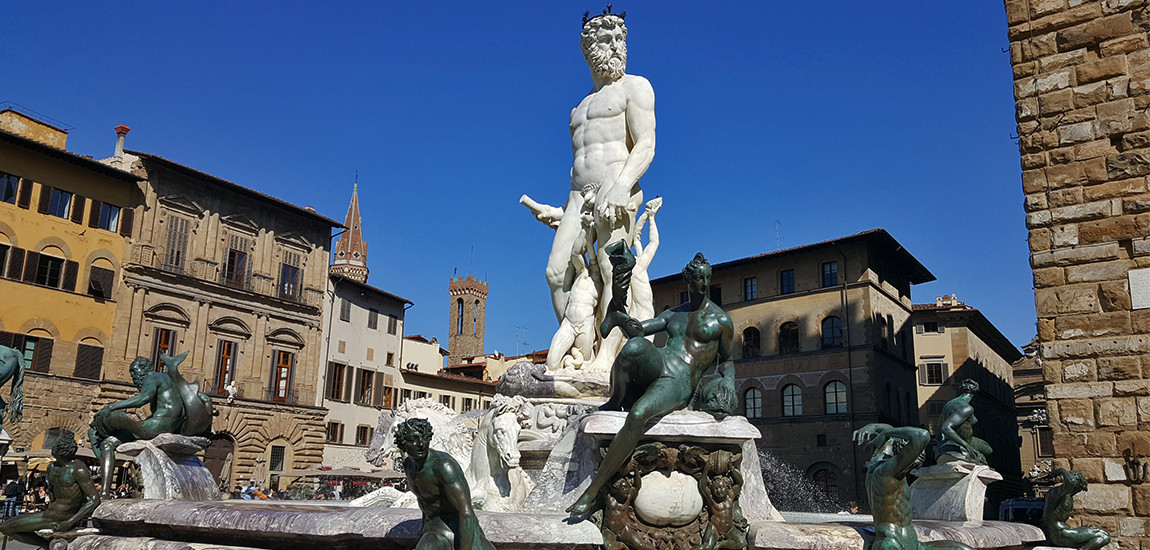
The Biancone is shining bright again
The Fontana del Nettuno was finally inaugurated after a two-year restoration, generously funded by the Ferragamo fashion house.
In 1559 Cosimo I de Medici announced a competition to design the first public fountain in Florence, which thanks to the construction of a new aqueduct would bring water to the city center, in Piazza della Signoria.
Many great artists of the time participated in the competition, such as Baccio Bandinelli, Benvenuto Cellini, Bartolomeo Ammannati and Giambologna.
Baccio Bandinelli, who had already made the statue of Hercules and Cacus to be placed in front of the entrance to the Palazzo della Signoria, was chosen for the commission, but managed to complete only the drawing before he died in 1560. The project was then passed on to Bartolomeo Ammannati who was setting to create his beautiful Nettuno, symbol of the maritime successes achieved by the Grand Duchy of Tuscany at that time. Not surprisingly, the face of the god of the sea appears very similar to that of the Grand Duke Cosimo I, who dominates the square with pride.
Having emerged defeated by the dispute for the commission, Ammannati's historic rival, Benvenuto Cellini, did not take it very well. It is said that he commented on this decision, pointing out that the poor piece of marble that had fallen into the hands of the Ammannati had a very unfortunate fate.
It is known there was bad blood between the two. In the past, Ammannati had publicly accused Cellini of sodomy, and for his part, Cellini had already spoken about the statue of Hercules and Cacus, calling it "a sack of melons hanging on a wall". The poor Ammannati, who had always been trying to imitate the anatomical perfection of Michelangelo without success, had in fact exaggerated a little too much in defining the muscles of the characters of the sculptural group, with very little natural results.
The statue of Neptune was to be inaugurated on the occasion of the wedding procession of Francesco I de Medici and Giovanna of Austria in 1565, which was to pass precisely through the Piazza della Signoria, but a series of unfortunate events delayed the end of the works, that happened only in 1574.
The Florentines did not welcome the new fountain with much enthusiasm, though. It was not really the emblem of the Florentine power they expected. They immediately nicknamed the statue of Neptune, the "Biancone" (great white giant), because of the blinding whiteness of the marble of which it was made. This nickname is still used today with affection and pride by the Florentines who by now have learned to love that gentle giant in Piazza della Signoria.
Right from the start, they used this new public fountain to wash their clothes and ink-filled inkwells, so much so that in 1720 it became necessary to put a plaque on the facade of the building forbidding such activities.
In front of the basin, instead, we find an epigraph that recalls the hanging and the burning of Girolamo Savonarola in May 1498.
The sculptural group of the fountain with octagonal basin is composed at the center by Neptune, standing on a chariot carried by sea horses that has celestial wheels decorated with zodiac signs, symbolizing the passage of time. Around it we find the marine deities Teti, Doride, Oceano and Nereo with a procession of bronze nymphs, satyrs and fauns by Giambologna. One of these very statues was stolen during the Carnival of 1830, when a group of vandals disguised it as one of them and took it away. It had to be replaced with a copy the following year.
But the misadventures of Ammannati’s fountain did not end there. In the summer of 2005, a vandal climbed up on the Biancone during the night, and then fell to the ground severing the hand of the statue he had been hanging on, damaging the basin below.
Neverthless, it is all in the past. The damage caused by the carelessness of people and centuries has been erased by the two years of restoration that the sculptural group underwent, returning to its original splendor.
Even the hydraulic system has started working again, making the choreographic water games originally designed by Ammannati work again, as it hadn't been possible since 1987.
Finally we can appreciate the first public fountain in Florence in all its beauty!



